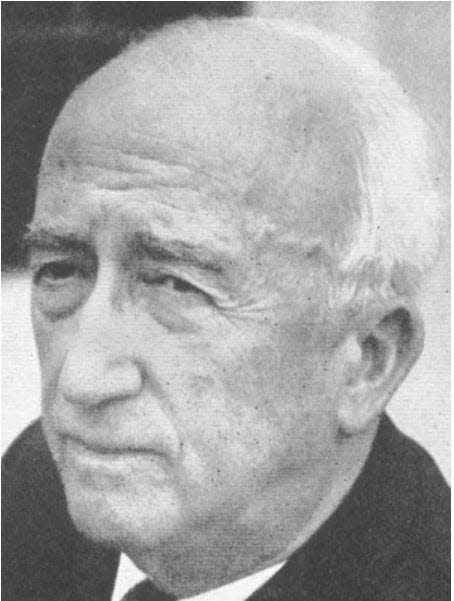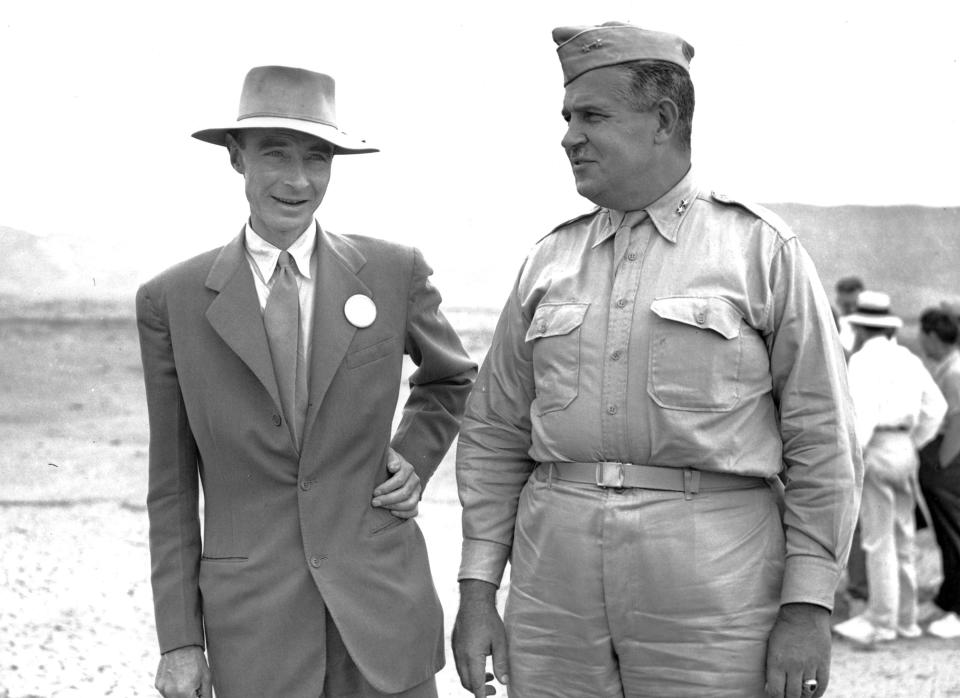Watching 'Oppenheimer'? Here's how a Spartanburg, SC home played role in use of the bomb
- Oops!Something went wrong.Please try again later.
- Oops!Something went wrong.Please try again later.
- Oops!Something went wrong.Please try again later.
Editor's Note: This story was originally published on GoUpstate on Aug. 12, 2005.
A front porch in Converse Heights wasn't so much the birthplace of America's decision to drop atomic bombs on Hiroshima and Nagasaki 60 years ago as it was one of the last places that decision could have been prevented, a retired history professor says.
Distinguished statesman and "assistant president" James F. Byrnes was staying on Crystal Lane shortly before and while serving as secretary of state under President Harry Truman. He made many trips between Spartanburg and Washington during the spring of 1945.
Some historical retellings have since evolved to label that home, then owned by Byrnes' colleague Donald Russell, as the site where The Decision was made — the one that led to the deaths of more than 200,000 people and the end of World War II.
While that may be arguable as the president was likely present at the time of the final decision and he wasn't in Spartanburg, certainly meetings and conversations that happened here guided Byrnes, whom Truman had asked to represent him on a so-called Interim Committee of top military and science advisers.

One Spartanburg meeting, in particular, was key, says Alice Henderson.
That spring was one defined by a struggle between scientists and politicians and the military.
"If Byrnes had been impressed with the scientists' arguments, that would have carried a lot of weight with the president," said Henderson, 71, who has been teaching at the University of South Carolina Upstate for 30 years. She believes Japan was close to surrendering anyway.
"If the scientists had managed to convince Byrnes that this wasn't a good thing to do, they likely could have convinced Truman to hold off another three weeks, and then it might not have happened."
Who was J. Robert Oppenheimer? What to know about atomic bomb physicist's life, career, death
Why Christopher Nolan made Oppenheimer: Christopher Nolan made 'Oppenheimer' because he thought he'd die in a nuclear Armageddon
Scientist warned against use of atomic bomb against cities in Japan
Albert Einstein sent a letter to President Franklin Roosevelt on March 25, 1945, vouching for the reputation of fellow scientist Leo Szilard and requesting a meeting between the two.
Szilard was concerned about the lack of communication between the atomic scientists and the policymakers. He wasn't alone.
He'd prepared a memo that "warned that the use of the bomb against the cities in Japan would start an atomic-arms race with Russia, and it raised the question of whether avoiding such an arms race might not be more important than the short-term goal of knocking Japan out of the war," according to a 1960 interview in U.S. News & World Report.
Einstein's letter was still in the president's office when Roosevelt died and Truman, at that point out of the atomic loop, was sworn in. Truman planned to appoint Byrnes as secretary of state and asked him to meet with Szilard.
Szilard, Nobel Laureate Harold Urey and University of Chicago Dean Walter Bartky took the train to Spartanburg to meet with Byrnes on May 27, 1945.
Szilard would leave dissatisfied. Five days later, Byrnes and the Interim Committee would unanimously recommend to Truman that the bomb "should be used without specific warning and as soon as practicable," Byrnes wrote in his 1958 biography, "All in One Lifetime."
The scientist wanted to discuss the matter with Truman's Cabinet, which Byrnes "did not feel desirable."
"His general demeanor and his desire to participate in policy making made an unfavorable impression on me, but his associates were neither as aggressive nor apparently as dissatisfied," Byrnes wrote.
He further wrote he was "impressed" that Gen. Leslie Groves, head of the Manhattan Project, had intelligence officers follow the scientists here.
Henderson believes that the scientists resented that, that they pleaded the case of dropping a bomb on an uninhabited area to show Japan what could happen without a surrender, and that they left depressed.
Byrnes trusted Groves more than he trusted the scientists, she said.
"The scientists thought they could accomplish the goal of getting Japan to surrender without actually dropping the bomb," Henderson said. "They believed using a bomb for military purposes would start a tradition in which America would be the long-term loser."

'Targeting of civilians as a legitimate instrument of warfare'
Stanford University professor David Kennedy wrote in Time magazine last week that the U.S. had crossed a "moral threshold" years before the meetings of the Interim Committee, "when it accepted the targeting of civilians as a legitimate instrument of warfare" -- something Truman reportedly never wanted to do.
Kennedy puts forth that the committee members spent "only about 10 minutes on a lunch break discussing a possible demonstration of the bomb's effect in an unpopulated area."
"The political situation -- what will play at home -- Byrnes had a good feel for that," Henderson said. "The scientific community, which might have been a little more idealistic they were less interested in the political consequences of 'bringing the boys back home.' Just like now, with all the talk about getting us out of Iraq."
Congress, after all, had pumped a few billion dollars into the atomic bomb program.
And years later, Szilard -- who was a key player in developing the bomb -- would continue trying to get scientists to put more pressure on the government for atomic energy control, Henderson said.
Spartanburg meeting 'lost opportunity to change history'
The Herald-Journal reported in 1995 that "the decision that leveled two Japanese cities began with meetings held in a Converse Heights home in Spartanburg."
That's true ― despite the lore that's sprung out of it.
John Edmunds, another retired professor teaching at USC Upstate, worked with Donald Russell, a former S.C. governor and, in early 1945, the deputy director of the War Mobilization and Reconstruction Office under Byrnes.
"Mr. Russell, frankly, played it down," Edmunds said of the actions on Crystal Lane.
"It just happened to be there they got to meet. They didn't make the decision, though. The president made the decision."
Henderson says she remains without an opinion as to whether America did right or wrong. But she does believe that late May night was a "lost opportunity to change history."
"We just don't know enough to know if dropping the bomb, in the long run, saved lives," she said.
This article originally appeared on Herald-Journal: 'Oppenheimer': How a Spartanburg home played role in atomic bomb use

